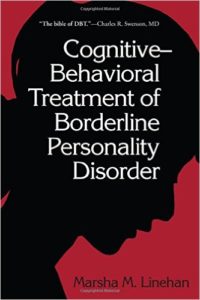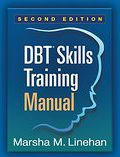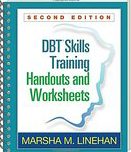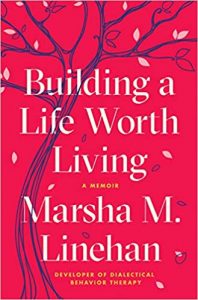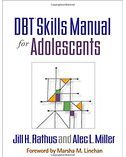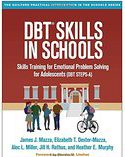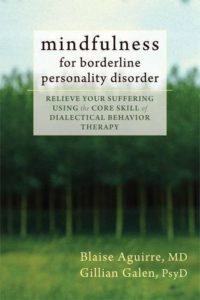PDBTI strives to inform and educate professionals and the public about effective scientifically-validated behavioral treatments for BPD and other mental health issues. Below is a handpicked selection of many of the best DBT and behavioral publications written by internationally recognized DBT and other behavioral experts.
As an Amazon Associate PDBTI earns from qualifying purchases.
Cognitive-Behavioral Treatment of Borderline Personality Disorder1st Edition
by
For the average clinician, individuals with borderline personality disorder (BPD) often represent the most challenging, seemingly insoluble cases. This volume is the authoritative presentation of dialectical behavior therapy (DBT), Marsha M. Linehan’s comprehensive, integrated approach to treating individuals with BPD. DBT was the first psychotherapy shown in controlled trials to be effective with BPD. It has since been adapted and tested for a wide range of other difficult-to-treat disorders involving emotion dysregulation. While focusing on BPD, this book is essential reading for clinicians delivering DBT to any clients with complex, multiple problems.
Companion volumes: The latest developments in DBT skills training, together with essential materials for teaching the full range of mindfulness, interpersonal effectiveness, emotion regulation, and distress tolerance skills, are presented in Linehan’s DBT® Skills Training Manual, Second Edition, and DBT® Skills Training Handouts and Worksheets, Second Edition. Also available: Linehan’s instructive skills training videos for clients–Crisis Survival Skills: Part One, Crisis Survival Skills: Part Two, From Suffering to Freedom, This One Moment, and Opposite Action. Plus related DBT videos: DBT at a Glance: An Introduction to Dialectical Behavior Therapy, DBT at a Glance: The Role of the Psychiatrist on the DBT Team, and Getting a New Client Connected to DBT (Complete Series).
DBT Skills Training Manual2nd Edition
by
From Marsha M. Linehan–the developer of dialectical behavior therapy (DBT)–this comprehensive resource provides vital tools for implementing DBT skills training. The reproducible teaching notes, handouts, and worksheets used for over two decades by hundreds of thousands of practitioners have been significantly revised and expanded to reflect important research and clinical advances. The book gives complete instructions for orienting clients to DBT, plus teaching notes for the full range of mindfulness, interpersonal effectiveness, emotion regulation, and distress tolerance skills. Handouts and worksheets are not included in the book; purchasers get access to a Web page where they can download and print all the handouts and worksheets discussed, as well as the teaching notes. The companion volume is available separately: DBT® Skills Training Handouts and Worksheets, Second Edition.
New to This Edition
*Handouts and worksheets (available online and in the companion volume) have been completely revised and dozens more added–more than 225 in all.
*Each module has been expanded with additional skills.
*Multiple alternative worksheets to tailor treatment to each client.
*More extensive reproducible teaching notes (provided in the book and online), with numerous clinical examples.
*Curricula for running skills training groups of different durations and with specific populations, such as adolescents and clients with substance use problems.
*Linehan provides a concise overview of “How to Use This Book.”
DBT Skills Training Handouts and Worksheets, Second Edition2nd Edition
by
Featuring more than 225 user-friendly handouts and worksheets, this is an essential resource for clients learning dialectical behavior therapy (DBT) skills, and those who treat them. All of the handouts and worksheets discussed in Marsha M. Linehan’s DBT® Skills Training Manual, Second Edition, are provided, together with brief introductions to each module written expressly for clients. Originally developed to treat borderline personality disorder, DBT has been demonstrated effective in treatment of a wide range of psychological and emotional problems. No single skills training program will include all of the handouts and worksheets in this book; clients get quick, easy access to the tools recommended to meet their particular needs. The 8 1/2″ x 11″ format and spiral binding facilitate photocopying. Purchasers also get access to a Web page where they can download and print additional copies of the handouts and worksheets.
Mental health professionals, see also the author’s DBT® Skills Training Manual, Second Edition, which provides complete instructions for teaching the skills. Also available: Cognitive-Behavioral Treatment of Borderline Personality Disorder, the authoritative presentation of DBT, and instructive videos for clients–Crisis Survival Skills: Part One, Crisis Survival Skills: Part Two, From Suffering to Freedom, This One Moment, and Opposite Action (all featuring Linehan), and DBT at a Glance: An Introduction to Dialectical Behavior Therapy (featuring Shari Y. Manning and Tony DuBose).
Building a Life Worth Living: A Memoir
by Paid Link
Over the years, DBT had saved the lives of countless people fighting depression and suicidal thoughts, but Linehan had never revealed that her pioneering work was inspired by her own desperate struggles as a young woman. Only when she received this question did she finally decide to tell her story.
In this remarkable and inspiring memoir, Linehan describes how, when she was eighteen years old, she began an abrupt downward spiral from popular teenager to suicidal young woman. After several miserable years in a psychiatric institute, Linehan made a vow that if she could get out of emotional hell, she would try to find a way to help others get out of hell too, and to build a life worth living. She went on to put herself through night school and college, living at the YWCA and often scraping together spare change to buy food. She went on to get her PhD in psychology, specializing in behavior therapy. In the 1980s, she achieved a breakthrough when she developed Dialectical Behavioral Therapy, a therapeutic approach that combines acceptance of the self and ways to change. Linehan included mindfulness as a key component in therapy treatment, along with original and specific life-skill techniques. She says, “You can’t think yourself into new ways of acting; you can only act yourself into new ways of thinking.”
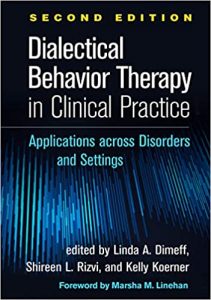 Dialectical Behavior Therapy in Clinical Practice: Applications across Disorders and Settings 2nd Edition
Dialectical Behavior Therapy in Clinical Practice: Applications across Disorders and Settings 2nd Edition
by
First developed to treat suicidal individuals with borderline personality disorder, dialectical behavior therapy (DBT) has since been adapted to a range of settings and populations. This practical book–edited by close collaborators of DBT originator Marsha M. Linehan–presents applications for depression, substance dependence, eating disorders, psychosis, suicidal and assaultive behaviors, and other complex problems. Leading contributors, including Linehan herself, describe how to implement this evidence-based treatment with adults, adolescents, couples and families, and forensic clients. Issues in establishing and maintaining an effective DBT program are also addressed. Over a dozen reproducible worksheets and forms can be downloaded and printed in a convenient 8 1/2″ x 11″ size.
This influential work has now been substantially revised with over 60% new material reflecting over a dozen years of research and clinical advances. Leading experts describe innovative ways to use dialectical behavior therapy (DBT) in a wide range of real-world clinical and community settings. The volume provides wise guidance on setting up, running, and evaluating a comprehensive DBT program. It also presents adaptations designed to meet the needs of particular client populations as time- and cost-effectively as possible. Vivid case examples illustrate diverse applications of DBT for helping adults, adolescents, and children reduce suicidal and self-harming behavior; overcome complex, multiple challenges; and build a life worth living.
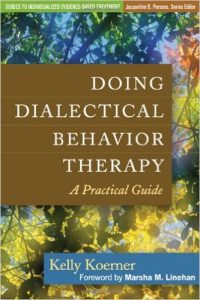 Doing Dialectical Behavior Therapy: A Practical Guide
Doing Dialectical Behavior Therapy: A Practical Guide
by
Filled with vivid clinical vignettes and step-by-step descriptions, this book demonstrates the nuts and bolts of dialectical behavior therapy (DBT). DBT is expressly designed for–and shown to be effective with–clients with serious, multiple problems and a history of treatment failure. The book provides an accessible introduction to DBT while enabling therapists of any orientation to integrate elements of this evidence-based approach into their work with emotionally dysregulated clients. Experienced DBT clinician and trainer Kelly Koerner clearly explains how to formulate individual cases; prioritize treatment goals; and implement a skillfully orchestrated blend of behavioral change strategies, validation strategies, and dialectical strategies.
DBT Skills Manual for Adolescents
By
From leading experts who have trained thousands of professionals in dialectical behavior therapy (DBT), this manual provides indispensable tools for treating adolescents with emotional or behavioral problems of any level of severity. Clinicians are guided step by step to teach teens and parents five sets of skills: Mindfulness, Distress Tolerance, Walking the Middle Path (a family-based module developed by the authors specifically for teens), Emotion Regulation, and Interpersonal Effectiveness. Designed for optimal clinical utility, the book features session outlines, teaching notes, discussion points, examples, homework assignments, and 85 reproducible handouts, in a large-size format for easy photocopying. Purchasers also get access to a Web page where they can download and print the reproducible materials.
DBT Skills in Schools: Skills Training for Emotional Problem Solving for Adolescents
by
Dialectical behavior therapy (DBT) skills have been demonstrated to be effective in helping adolescents manage difficult emotional situations, cope with stress, and make better decisions. From leading experts in DBT and school-based interventions, this unique manual offers the first nonclinical application of DBT skills. The book presents an innovative social–emotional learning curriculum designed to be taught at the universal level in grades 6-12. Explicit instructions for teaching the skills–mindfulness, distress tolerance, emotion regulation, and interpersonal effectiveness–are provided in 30 lesson plans, complete with numerous reproducible tools: 99 handouts, a diary card, and three student tests. The large-size format and lay-flat binding facilitate photocopying; purchasers also get access to a Web page where they can download and print the reproducible materials.
This book is in The Guilford Practical Intervention in the Schools Series.
by
The key to flexible, skillful decision making in dialectical behavior therapy (DBT) lies in understanding the connections between moment-to-moment clinical strategies and core principles. This lucid guide from leading DBT authority Charles R. Swenson offers clinicians a compass for navigating challenging clinical situations and moving therapy forward–even when change seems impossible. Numerous vivid case examples illustrate DBT in action and show how to use skills and strategies that flow directly from the fundamental paradigms of acceptance, change, and dialectics. Clinicians gain knowledge and confidence for meeting the complex needs of each client while implementing DBT with fidelity.
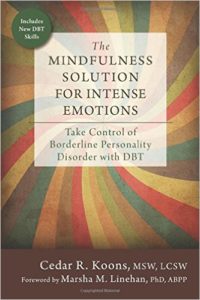 The Mindfulness Solution for Intense Emotions: Take Control of Borderline Personality Disorder with DBT
The Mindfulness Solution for Intense Emotions: Take Control of Borderline Personality Disorder with DBT
by Paid Link
The Mindfulness Solution for Intense Emotions offers breakthrough, new mindfulness skills and exercises drawn from dialectical behavior therapy (DBT) to help you move past harmful emotions.
If you suffer from intense emotions, you are not alone. Millions of Americans are diagnosed with emotion regulation disorders, such as borderline personality disorder (BPD) and other comorbid conditions like post-traumatic stress disorder (PTSD), and severe depression. Developed by Marsha Linehan, DBT is a clinically proven, evidence-based treatment for intense emotions that can help you start feeling better right away. This is the first consumer-friendly book to offer Linehan’s new mindfulness skills to help you take control of your emotions, once and for all.
In this book, you’ll learn seven powerful skills that highlight the unique connection between mindfulness and emotion regulation. Each skill is designed to help you find focus in the present moment, reduce impulsive behavior, and increase a sense of connection to your true self, even during times of extreme stress or difficulty.
You can feel calmer, more grounded, and centered. If you’re ready, the mindfulness practices in this book will help you move away from a chaotic, emotion-driven life and cultivate a focused, intentional one.
 The High-Conflict Couple: A Dialectical Behavior Therapy Guide to Finding Peace, Intimacy, and Validation
The High-Conflict Couple: A Dialectical Behavior Therapy Guide to Finding Peace, Intimacy, and Validation
by Paid Link
You hear and read a lot about ways to improve your relationship. But if you’ve tried these without much success, you’re not alone. Many highly reactive couples—pairs that are quick to argue, anger, and blame—need more than just the run-of-the-mill relationship advice to solve their problems in love. When destructive emotions are at the heart of problems in your relationship, no amount of effective communication or intimacy building will fix what ails it. If you’re part of a “high-conflict” couple, you need to get control of your emotions first, to stop making things worse, and only then work on building a better relationship.
The High-Conflict Couple adapts the powerful techniques of dialectical behavior therapy (DBT) into skills you can use to tame out-of-control emotions that flare up in your relationship. Using mindfulness and distress tolerance techniques, you’ll learn how to de-escalate angry situations before they have a chance to explode into destructive fights. Other approaches will help you disclose your fears, longings, and other vulnerabilities to your partner and validate his or her experiences in return. You’ll discover ways to manage problems with negotiation, not conflict, and to find true acceptance and closeness with the person you love the most.
Brief Alcohol Screening and Intervention for College Students (BASICS): A Harm Reduction Approach1st Edition
by
This instructive manual presents a pragmatic and clinically proven approach to the prevention and treatment of undergraduate alcohol abuse. The BASICS model is a non-confrontational harm reduction approach that helps students reduce their alcohol consumption and decrease the behavioral and health risks associated with heavy drinking. Including numerous reproducible handouts and assessment forms, the book takes readers step by step through conducting BASICS assessment and feedback sessions. Special topics include the use of DSM-IV criteria to evaluate alcohol abuse, ways to counter student defensiveness about drinking, and obtaining additional treatment for students with severe alcohol dependency.
Handbook of Emotion Regulation, Third Edition
by
Reviewing the state of the science in a dynamic, thriving field, this influential handbook integrates knowledge from multiple psychological subdisciplines. Foremost experts address the neurobiological and cognitive bases of emotion regulation and examine how individuals develop and use regulatory strategies across the lifespan. The social context of emotion regulation is explored, as are personality processes and individual differences. Critical implications are discussed for psychopathology, psychosocial interventions, and health. Including helpful cross-referencing among chapters, the volume describes cutting-edge methods and identifies promising directions for future investigation. As a special bonus, purchasers of the second edition can download a supplemental e-book featuring several notable, highly cited chapters from the first edition.
New to This Edition
- Broader coverage to bring readers up to speed on the ever-growing literature—features 71 concise chapters, compared to 36 in the prior edition.
- Reflects a decade of continuing, rapid advances in theory and research methods.
- New sections on emotion regulation in groups and collectives, specific emotion regulation processes, nonclinical interventions, and emotion regulation across disciplines.
- Increased attention to the role of emotion regulation in culture, and broader societal issues.
Mindfulness for Borderline Personality Disorder: Relieve Your Suffering Using the Core Skill of Dialectical Behavior Therapy
by Paid Link
If you are like many others living with borderline personality disorder (BPD), you know what it’s like to be overwhelmed by intense and fluctuating emotions; to have difficulty with relationships; and to constantly struggle with troubling thoughts and behaviors. BPD can be especially difficult to treat, though there are ways to gain control over your symptoms and live a happier, healthier life.
Expanding on the core skill of dialectical behavior therapy (DBT), Mindfulness for Borderline Personality Disorder will help you target and successfully manage many of the familiar symptoms of BPD. Inside, you will learn the basics of mindfulness through specific exercises, and will gain powerful insight through real-life stories from people who have BPD. If you are ready to take that first step on the path toward wellness, this book will be your guide.
 Overcoming Borderline Personality Disorder: A Family Guide for Healing and Change
Overcoming Borderline Personality Disorder: A Family Guide for Healing and Change
by Paid Link
Overcoming Borderline Personality Disorder is a compassionate and informative guide to understanding this profoundly unsettling–and widely misunderstood–mental illness, believed to affect approximately 6% of the general population. Rather than viewing people with BPD as manipulative opponents in a bitter struggle, or pitying them as emotional invalids, Valerie Porr cites cutting-edge science to show that BPD is a true neurobiological disorder and not, as many come to believe, a character flaw or the result of bad parenting. Porr then clearly and accessibly explains what BPD is, which therapies have proven effective, and how to rise above the weighty stigma associated with the disorder. Offering families and loved ones supportive guidance that both acknowledges the difficulties they face and shows how they can be overcome, Porr teaches empirically-supported and effective coping behaviors and interpersonal skills, such as new ways of talking about emotions, how to be aware of nonverbal communication, and validating difficult experiences. These skills are derived from Dialectical Behavior Therapy and Mentalization-based Therapy, two evidence-based treatments that have proven highly successful in reducing family conflict while increasing trust. Overcoming Borderline Personality Disorder is an empowering and hopeful resource for those who wish to gain better understanding of the BPD experience–and to make use of these insights in day-to-day family interactions.
Winner of the ABCT Self Help Book Seal of Merit Award 2011!
 Behavioral Interventions in Cognitive Behavior Therapy: Practical Guidance for Putting Theory Into ActionSecond Edition
Behavioral Interventions in Cognitive Behavior Therapy: Practical Guidance for Putting Theory Into ActionSecond Edition
by Paid Link
This book offers a step-by-step guide to behavioral interventions in cognitive behavior therapy (CBT). The authors discuss case formulation and treatment planning, core behavioral intervention strategies, and innovative approaches such as acceptance, mindfulness, and a behavioral approach to cognition. They examine key behavioral techniques including self-monitoring, behavioral activations, exposure therapy, and skills training, that are essential features of CBT practice. This practical behavioral framework is accessible to clinicians and students with varying degrees of behavioral training. Alongside a comprehensive update of the research literature, this edition features new chapters on enhancing interpersonal effectiveness, emotion regulation, and navigating difficult therapeutic challenges.
by Paid Link
What happens when clients and practitioners get in the way of the therapy process? Therapy-interfering behavior (TIB) is a common issue. It can be intentional or unintentional, strategic or automatic, calculated or absent-minded, and sometimes it may come from the practitioner, or be mutually acted out with the client.
This highly approachable book presents strategies using dialectical behavior therapy (DBT), and addresses a large variety of common therapeutic challenges — including problems with attendance, homework compliance, passive or aggressive behavior, and avoidance. Backed by a strong DBT framework, and supported by empirical discussion, case studies, and examples of therapeutic interactions, Managing Therapy-Interfering Behaviors: Strategies from Dialectical Behavior Therapy also takes the bold step of addressing how therapists can address their own therapy-interfering behavior. Topics such as therapist burnout and what to do when clients appear to be pushing therapeutic limits are covered.
The strategies presented apply to many types of patients, in many settings. With original research, detailed procedures, and concise syntheses of the large amount of research available, this book is a vital source for both seasoned DBT clinicians and those seeking to introduce elements of DBT in their clinical practice.
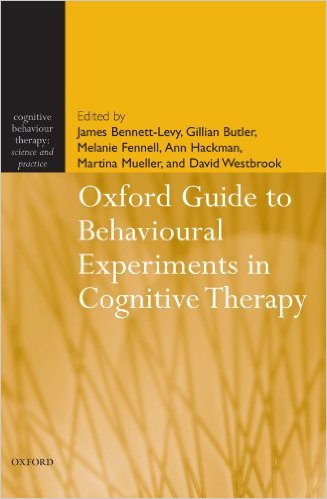 Oxford Guide to Behavioural Experiments in Cognitive Therapy (Cognitive Behaviour Therapy: Science and Practice)
Oxford Guide to Behavioural Experiments in Cognitive Therapy (Cognitive Behaviour Therapy: Science and Practice)
by Paid Link
Behavioral experiments are one of the central and most powerful methods of intervention in cognitive therapy. Yet until now, there has been no volume to guide clinicians wishing to design and implement behavioral experiments.Behavioural Experiments in Cognitive Therapy fills this gap. It is written by clinicians for clinicians. It is a practical, easy to read handbook, which is relevant for practicing clinicians at every level, from trainees to cognitive therapy supervisors.
Following an introduction by David Clark, the first two chapters provide a theoretical and practical background for the understanding and development of behavioral experiments. Thereafter, the remaining chapters of the book focus on particular problem areas. These include problems which have been the traditional focus of cognitive therapy, such as depression and anxiety disorders, as well as those which have only once more recently become a subject of study, such as bipolar disorder and psychotic symptoms. Additionally, it includes some which are still int their relative infancy–physical health problems, and brain injury.
The book includes several chapters on transdiagnostic problems, such as avoidance of affect, low self-esteem, interpersonal issues, and self-injurious behavior. A final chapter by Christine Padesky provides some signposts for future development. Containing examples of over 200 behavioral experiments, this book will be of enormous practical value for all those involved in cognitive behavioral therapy, as well as stimulating exploration in both its readers and their patients.
Recommended Videos
What is dialectical behavior therapy for adolescents?: a great description of DBT from UC San Francisco
Paced Breathing (TIPP) – Long Version: helps therapists learn paced breathing for emotion regulation, and thoroughly explains how it works; some clients may prefer to watch the shorter version of this video that focuses more on what to do and much less on theory
Paced Breathing (TIPP) – Short Version: helps clients learn paced breathing for emotion regulation; the other video is longer, focusing much more on the underlying physiologically and how paced breathing works
Breathing Pacer (Flute): useful for the paced breathing emotion regulation skill in Dialectical Behavior Therapy.
As the balloon inflates, breathe in. As the balloon deflates, breathe out, and you’ll notice this way of breathing corresponds to the changes in pitch of the flute sounds. Match your breathing to the changing pitch sounds.
Breathing Pacer (Guitar): useful for the paced breathing emotion regulation skill in Dialectical Behavior Therapy.
As the balloon inflates, breathe in. As the balloon deflates, breathe out, and you’ll notice this way of breathing corresponds to the changes in pitch of the guitar sounds. Match your breathing to the changing pitch sounds.

